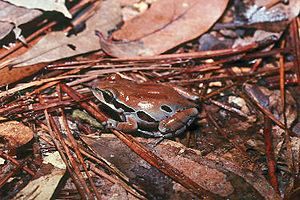Ornate chorus frog facts for kids
Quick facts for kids Ornate chorus frog |
|
|---|---|
 |
|
| Conservation status | |
| Scientific classification | |
| Synonyms | |
|
The ornate chorus frog (Pseudacris ornata) is a small type of chorus frog. It lives only in the southeastern part of the United States. This means it is endemic to that area.
Contents
What They Look Like
These frogs are quite small. They are about 25–38 mm (1–1.5 in) long from head to body. That's about the size of your thumb!
Their color can change. Some are green, while others are red or brown. This often depends on where they live.
They usually have a stripe or spots. These marks go from their nose down their side. The stripe might be broken up. Their belly is pure white. They also often have yellow spots. These spots are usually found in front of their back legs.
Where They Live
Ornate chorus frogs mostly live in the southern coastal plain. This is a flat area near the coast.
They prefer to live in longleaf pine flatwoods. These are forests with tall pine trees and flat ground.
How They Behave
These chorus frogs are active at night. This means they are nocturnal. Because of this, people rarely see them.
You are most likely to spot them during their mating season. This is when they come out more often.
Naming and Classification
The ornate chorus frog (Pseudacris ornata) was first named in 1836. An American herpetologist named John Edwards Holbrook classified it. A herpetologist is a scientist who studies amphibians and reptiles.
What Their Name Means
The name of the genus, Pseudacris, comes from two Greek words. Pseudes means "false" and akris means "locust." This name probably refers to the sound the frog makes. Most chorus frogs make a repeated, rasping trill. This sound is similar to what a locust insect sounds like.
The specific name, ornata, comes from Latin. It is the feminine form of the word ornatus, which means "decorated." So, the frog's full name means "false locust, decorated."
See also
 In Spanish: Pseudacris ornata para niños
In Spanish: Pseudacris ornata para niños


